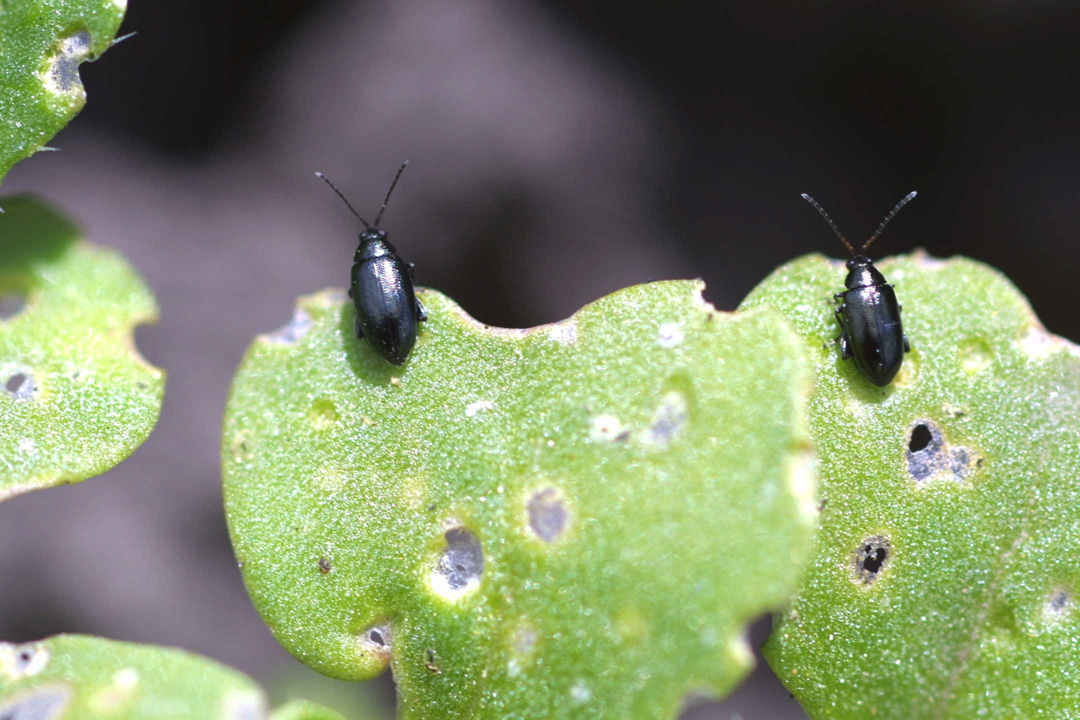Prepare for Flea Beetles
Striped flea beetles can devastate a crop within 36 hours
These insects are particularly troublesome because of their dense populations and voracious appetites. Though they are more active on warm, calm days, cooler weather doesn’t stop them — their activity may be reduced, but they continue to feed. This means that crop loss can occur very quickly, with some experts estimating leaf area loss advancing from 25 to 50 per cent in a matter of one day.
To prevent damage, scout early
Flea beetles become active during the first extended period of warm weather in the spring — usually between April and May. As you scout, you’ll be looking for damage done by adults. This is because flea beetles have one generation per year — adults will overwinter in field margins and grassy areas, then emerge in the spring to feed and mate. Offspring emerge as adults in the fall to feed before overwintering and beginning the cycle all over again.
As flea beetles are aggressive feeders that can devastate a crop in a short period, scouting early is your best defence, especially if conditions in your region favour the survival of adults.
These conditions could indicate high risk of flea beetle infestation:
- Warm, moist conditions in April and early May – favour egg survival.
- Sunny weather and dry conditions after seeding – makes the beetles more active.
- Black soil that warms up quickly on sunny days.
- Conditions that can reduce the duration of seed treatment efficacy:
- Above-average rainfall that saturates the soil during germination and seedling emergence.
- High temperatures (20-30°C) during germination and seedling emergence.
- Seed treatments are only effective for a few weeks. If canola seedlings grow slowly due to extended cold or dry periods, the protection offered by seed treatments could be lost while small seedlings are still vulnerable to flea beetles.
Factors that increase the risk of flea beetle damage
If you are working with any of these challenges, scout fields every two days, looking for signs of flea beetle damage on field edges:
1. Low seeding rates
Crop damage is exacerbated when flea beetles can only feed on a few plants. When you have fewer plants, it’s more important to protect each one. Monitor fields more closely.
2. Late seeding dates
For most growers in Canada, seeding later in the spring isn’t necessarily a challenge: it means warmer soil and faster germination. However, we’re including this case in the list because it also means that crops emerge during warmer weather, when flea beetles are actively feeding. If you seeded later, be sure to scout often until your crops reach the four-leaf stage: once they’re past this stage and are growing a new leaf every day, they can typically out-compete flea beetles.
Crops can typically out-compete flea beetles once they're past the four-leaf stage and are growing a new leaf every day. If rain or other factors keep growers from seeding until later in the spring, the crop emerges when temperatures are warmer and flea beetles are actively feeding.
3. Poor crop vigour
If the weather turns cold or very dry and growth stalls, or if the plants do not have good early-season vigour, they remain smaller for a longer period and are more vulnerable to flea beetle damage.
4. Conventional tillage
Flea beetles are less active under minimal and zero-till conditions. The thatch left by the crop stubble is cool, shaded and more difficult for the beetles to navigate. In conventional tillage systems, flea beetles are more active and can cause more damage.
Spray foliar insecticide when 25% of the plant is damaged. Studies show that flea beetles don’t reduce crop yield until 25% damage.

Source: Canola Council of Canada
When necessary, apply a foliar insecticide like SILENCER® 120 EC. This Lambda-cyhalothrin insecticide is registered for use in canola, wheat, barley, oats and many other crops. For convenience, canola growers can tank mix Silencer with glyphosate, Liberty® or Odyssey®.
For best results, be sure that flea beetles are active when spraying, but avoid doing so in the heat of the day.
A study by the University of North Dakota found that when flea beetle pressure is high, delaying the foliar application by even one or two days could result in the loss of an entire field.
It’s also important to note that seed treatments don’t provide the same level of protection they used to, and some company rebate programs don’t support other insecticides resprays as much as they have in the past.
With SILENCER, you know you’re getting a reliable product with no hoops to jump through and no programs to manage.
Don’t get caught without protection, make sure you have your SILENCER this season.
For more information, check out these resources:
- SILENCER product information
- Flea Beetles, Canola Council of Canada
- Flea Beetles, Government of Ontario
- Flea Beetles on Canola and Mustard, Government of Manitoba
- Flea Beetle Forecast and Control, Government of Alberta